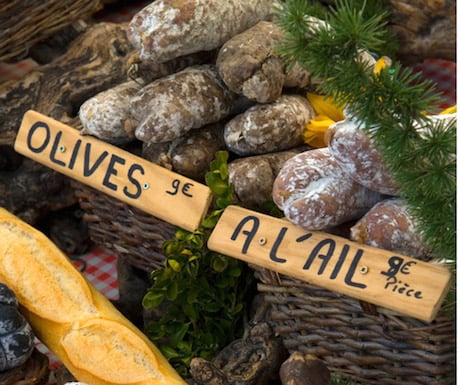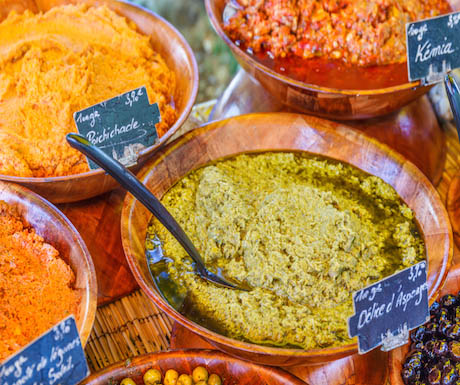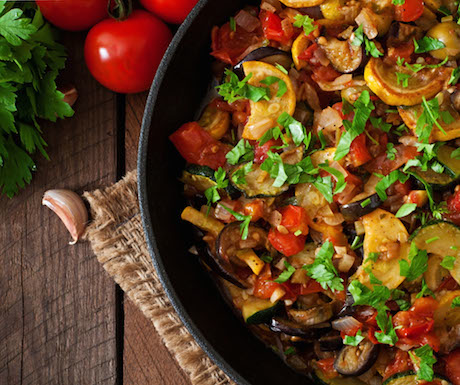Gastronomy in Provence for fine palates
Provence, a region which has always been rich in distinctive culinary offerings, from bouillabaisse to tapenade, has seen a recent surge in the popularity of gourmet cooking classes and lessons from private chefs, as a novel extra element of a luxury break in this idyllic corner of Southern France.
 Many of the best courses offer the opportunity to enjoy spectacular surroundings whilst quickly picking up tricks of the trade and the knowledge of a few show-stopping new signature dishes to take home. Les Cuisins du Sud is Marc Heracles one day course in true Provençale classics within the confines of a gorgeous manor house outside Aix en Provence. La Mirande, Avignon has been offering classic cookery courses for over twenty years at its legendary cookery school Le Marmiton. Far from resting on its laurels, however, Le Marmiton has been notable for its innovation and ability to move with the changing needs of luxury travellers. As a bespoke experience, it is happy to offer private cookery classes to accommodate groups of seven to fourteen people (the upper limit for the regular classes is twelve). There are also childrens cookery courses on offer, a brilliant and tasty way of immersing youngsters in the culture and ethos of the region whilst they visit. The larger than average group sizes are ideal for guests staying in one of the larger villas that the region boasts, for a family reunion or special occasion.
Whilst getting involved and learning the ropes might be the most proactive route into a deeper understanding of Provençale gastronomy, an easier and equally delectable path is to enjoy one of the many local Michelin starred restaurants.
Many of the best courses offer the opportunity to enjoy spectacular surroundings whilst quickly picking up tricks of the trade and the knowledge of a few show-stopping new signature dishes to take home. Les Cuisins du Sud is Marc Heracles one day course in true Provençale classics within the confines of a gorgeous manor house outside Aix en Provence. La Mirande, Avignon has been offering classic cookery courses for over twenty years at its legendary cookery school Le Marmiton. Far from resting on its laurels, however, Le Marmiton has been notable for its innovation and ability to move with the changing needs of luxury travellers. As a bespoke experience, it is happy to offer private cookery classes to accommodate groups of seven to fourteen people (the upper limit for the regular classes is twelve). There are also childrens cookery courses on offer, a brilliant and tasty way of immersing youngsters in the culture and ethos of the region whilst they visit. The larger than average group sizes are ideal for guests staying in one of the larger villas that the region boasts, for a family reunion or special occasion.
Whilst getting involved and learning the ropes might be the most proactive route into a deeper understanding of Provençale gastronomy, an easier and equally delectable path is to enjoy one of the many local Michelin starred restaurants.
 Provence boasts two restaurants with three Michelin stars: La Vague d’Or in Saint Tropez and the classic spot Le petit Nice in Marseilles. The latter has some recent further competition as Marseilles Michelin numbers have increased. This is partly thanks to the dynamic and extremely youthful Ludovic Turac, at Une Table au Sud, but in equal measure to the eponymous culinary hero of AM par Alexandre Mazzia. What all these, in many ways very different, restaurants share is simple: an ability to communicate the sensory experience and journey not just of the cooking of Provence but of the complex sensory sensation of simply being in the South of France. The dishes evoke the sea, the fresh air, the wildlife rustling, swimming and soaring in the forests and off the coast.
In Provence, though, highly enjoyable and fashionable as it is, its not necessary to seek out Michelin stars or cookery schools to find great food. Ratatouille may be a familiar and well-loved dish the world over, but it somehow tastes better in its area of origin, not least because of the exceptional local vegetables and olive oil that go into it. Simply being in Provence adds an extra piquancy and zest to garlic mayonnaise, or aïoli, too. Aïoli is given the fanfare that it truly merits in Provence, enlivening potatoes and raw vegetables as well as the ubiquitous shellfish. Tarte aux figues, a light confection of caramelised figs, is a dish perhaps less familiar to visitors, and all the more unmissable for that. Another revealing discovery is the hearty daube Provençale, a beef stew with red wine, onions and pasta on the side, which provides a persuasive reminder that Provençal gastronomy stretches across all four seasons, far surpassing the summery pink wine and light salads of popular imagination.
Provence boasts two restaurants with three Michelin stars: La Vague d’Or in Saint Tropez and the classic spot Le petit Nice in Marseilles. The latter has some recent further competition as Marseilles Michelin numbers have increased. This is partly thanks to the dynamic and extremely youthful Ludovic Turac, at Une Table au Sud, but in equal measure to the eponymous culinary hero of AM par Alexandre Mazzia. What all these, in many ways very different, restaurants share is simple: an ability to communicate the sensory experience and journey not just of the cooking of Provence but of the complex sensory sensation of simply being in the South of France. The dishes evoke the sea, the fresh air, the wildlife rustling, swimming and soaring in the forests and off the coast.
In Provence, though, highly enjoyable and fashionable as it is, its not necessary to seek out Michelin stars or cookery schools to find great food. Ratatouille may be a familiar and well-loved dish the world over, but it somehow tastes better in its area of origin, not least because of the exceptional local vegetables and olive oil that go into it. Simply being in Provence adds an extra piquancy and zest to garlic mayonnaise, or aïoli, too. Aïoli is given the fanfare that it truly merits in Provence, enlivening potatoes and raw vegetables as well as the ubiquitous shellfish. Tarte aux figues, a light confection of caramelised figs, is a dish perhaps less familiar to visitors, and all the more unmissable for that. Another revealing discovery is the hearty daube Provençale, a beef stew with red wine, onions and pasta on the side, which provides a persuasive reminder that Provençal gastronomy stretches across all four seasons, far surpassing the summery pink wine and light salads of popular imagination.
 Daube is the exception that proves the rule, however, in that it is typically fish and vegetables which take centre stage in Provence. Artichokes barigoules lets the flavour of the most delicious member of the thistle family shine with white wine, oil and judicious seasoning. Tomatoes are an important element in the preparation of both cod Provençal and most recipes exploiting the firm and savoury red mullet. Perhaps best-known and venerated of all is bouillabaisse. To enjoy this fish soup the classic Provence way, classic ingredients include gurnard, rockfish, monkfish and John Dory. Saffron is essential to complete both the soup and the colourful rouille that accompanies the crispy bread. Real authenticity can be achieved by first enjoying the broth with the bread garnish and then eating the fish with simple sliced potatoes. This soup is not meant to be savoured solo: like so many experiences in Provence, it works best with a group of pleasure-loving relatives or friends.
Paola Fiocchi Van den Brande is Director of Passepartout Homes Ltd.
If you would like to be a guest blogger on A Luxury Travel Blog in order to raise your profile, please contact us.
Daube is the exception that proves the rule, however, in that it is typically fish and vegetables which take centre stage in Provence. Artichokes barigoules lets the flavour of the most delicious member of the thistle family shine with white wine, oil and judicious seasoning. Tomatoes are an important element in the preparation of both cod Provençal and most recipes exploiting the firm and savoury red mullet. Perhaps best-known and venerated of all is bouillabaisse. To enjoy this fish soup the classic Provence way, classic ingredients include gurnard, rockfish, monkfish and John Dory. Saffron is essential to complete both the soup and the colourful rouille that accompanies the crispy bread. Real authenticity can be achieved by first enjoying the broth with the bread garnish and then eating the fish with simple sliced potatoes. This soup is not meant to be savoured solo: like so many experiences in Provence, it works best with a group of pleasure-loving relatives or friends.
Paola Fiocchi Van den Brande is Director of Passepartout Homes Ltd.
If you would like to be a guest blogger on A Luxury Travel Blog in order to raise your profile, please contact us.
 Many of the best courses offer the opportunity to enjoy spectacular surroundings whilst quickly picking up tricks of the trade and the knowledge of a few show-stopping new signature dishes to take home. Les Cuisins du Sud is Marc Heracles one day course in true Provençale classics within the confines of a gorgeous manor house outside Aix en Provence. La Mirande, Avignon has been offering classic cookery courses for over twenty years at its legendary cookery school Le Marmiton. Far from resting on its laurels, however, Le Marmiton has been notable for its innovation and ability to move with the changing needs of luxury travellers. As a bespoke experience, it is happy to offer private cookery classes to accommodate groups of seven to fourteen people (the upper limit for the regular classes is twelve). There are also childrens cookery courses on offer, a brilliant and tasty way of immersing youngsters in the culture and ethos of the region whilst they visit. The larger than average group sizes are ideal for guests staying in one of the larger villas that the region boasts, for a family reunion or special occasion.
Whilst getting involved and learning the ropes might be the most proactive route into a deeper understanding of Provençale gastronomy, an easier and equally delectable path is to enjoy one of the many local Michelin starred restaurants.
Many of the best courses offer the opportunity to enjoy spectacular surroundings whilst quickly picking up tricks of the trade and the knowledge of a few show-stopping new signature dishes to take home. Les Cuisins du Sud is Marc Heracles one day course in true Provençale classics within the confines of a gorgeous manor house outside Aix en Provence. La Mirande, Avignon has been offering classic cookery courses for over twenty years at its legendary cookery school Le Marmiton. Far from resting on its laurels, however, Le Marmiton has been notable for its innovation and ability to move with the changing needs of luxury travellers. As a bespoke experience, it is happy to offer private cookery classes to accommodate groups of seven to fourteen people (the upper limit for the regular classes is twelve). There are also childrens cookery courses on offer, a brilliant and tasty way of immersing youngsters in the culture and ethos of the region whilst they visit. The larger than average group sizes are ideal for guests staying in one of the larger villas that the region boasts, for a family reunion or special occasion.
Whilst getting involved and learning the ropes might be the most proactive route into a deeper understanding of Provençale gastronomy, an easier and equally delectable path is to enjoy one of the many local Michelin starred restaurants.
 Provence boasts two restaurants with three Michelin stars: La Vague d’Or in Saint Tropez and the classic spot Le petit Nice in Marseilles. The latter has some recent further competition as Marseilles Michelin numbers have increased. This is partly thanks to the dynamic and extremely youthful Ludovic Turac, at Une Table au Sud, but in equal measure to the eponymous culinary hero of AM par Alexandre Mazzia. What all these, in many ways very different, restaurants share is simple: an ability to communicate the sensory experience and journey not just of the cooking of Provence but of the complex sensory sensation of simply being in the South of France. The dishes evoke the sea, the fresh air, the wildlife rustling, swimming and soaring in the forests and off the coast.
In Provence, though, highly enjoyable and fashionable as it is, its not necessary to seek out Michelin stars or cookery schools to find great food. Ratatouille may be a familiar and well-loved dish the world over, but it somehow tastes better in its area of origin, not least because of the exceptional local vegetables and olive oil that go into it. Simply being in Provence adds an extra piquancy and zest to garlic mayonnaise, or aïoli, too. Aïoli is given the fanfare that it truly merits in Provence, enlivening potatoes and raw vegetables as well as the ubiquitous shellfish. Tarte aux figues, a light confection of caramelised figs, is a dish perhaps less familiar to visitors, and all the more unmissable for that. Another revealing discovery is the hearty daube Provençale, a beef stew with red wine, onions and pasta on the side, which provides a persuasive reminder that Provençal gastronomy stretches across all four seasons, far surpassing the summery pink wine and light salads of popular imagination.
Provence boasts two restaurants with three Michelin stars: La Vague d’Or in Saint Tropez and the classic spot Le petit Nice in Marseilles. The latter has some recent further competition as Marseilles Michelin numbers have increased. This is partly thanks to the dynamic and extremely youthful Ludovic Turac, at Une Table au Sud, but in equal measure to the eponymous culinary hero of AM par Alexandre Mazzia. What all these, in many ways very different, restaurants share is simple: an ability to communicate the sensory experience and journey not just of the cooking of Provence but of the complex sensory sensation of simply being in the South of France. The dishes evoke the sea, the fresh air, the wildlife rustling, swimming and soaring in the forests and off the coast.
In Provence, though, highly enjoyable and fashionable as it is, its not necessary to seek out Michelin stars or cookery schools to find great food. Ratatouille may be a familiar and well-loved dish the world over, but it somehow tastes better in its area of origin, not least because of the exceptional local vegetables and olive oil that go into it. Simply being in Provence adds an extra piquancy and zest to garlic mayonnaise, or aïoli, too. Aïoli is given the fanfare that it truly merits in Provence, enlivening potatoes and raw vegetables as well as the ubiquitous shellfish. Tarte aux figues, a light confection of caramelised figs, is a dish perhaps less familiar to visitors, and all the more unmissable for that. Another revealing discovery is the hearty daube Provençale, a beef stew with red wine, onions and pasta on the side, which provides a persuasive reminder that Provençal gastronomy stretches across all four seasons, far surpassing the summery pink wine and light salads of popular imagination.
 Daube is the exception that proves the rule, however, in that it is typically fish and vegetables which take centre stage in Provence. Artichokes barigoules lets the flavour of the most delicious member of the thistle family shine with white wine, oil and judicious seasoning. Tomatoes are an important element in the preparation of both cod Provençal and most recipes exploiting the firm and savoury red mullet. Perhaps best-known and venerated of all is bouillabaisse. To enjoy this fish soup the classic Provence way, classic ingredients include gurnard, rockfish, monkfish and John Dory. Saffron is essential to complete both the soup and the colourful rouille that accompanies the crispy bread. Real authenticity can be achieved by first enjoying the broth with the bread garnish and then eating the fish with simple sliced potatoes. This soup is not meant to be savoured solo: like so many experiences in Provence, it works best with a group of pleasure-loving relatives or friends.
Paola Fiocchi Van den Brande is Director of Passepartout Homes Ltd.
If you would like to be a guest blogger on A Luxury Travel Blog in order to raise your profile, please contact us.
Daube is the exception that proves the rule, however, in that it is typically fish and vegetables which take centre stage in Provence. Artichokes barigoules lets the flavour of the most delicious member of the thistle family shine with white wine, oil and judicious seasoning. Tomatoes are an important element in the preparation of both cod Provençal and most recipes exploiting the firm and savoury red mullet. Perhaps best-known and venerated of all is bouillabaisse. To enjoy this fish soup the classic Provence way, classic ingredients include gurnard, rockfish, monkfish and John Dory. Saffron is essential to complete both the soup and the colourful rouille that accompanies the crispy bread. Real authenticity can be achieved by first enjoying the broth with the bread garnish and then eating the fish with simple sliced potatoes. This soup is not meant to be savoured solo: like so many experiences in Provence, it works best with a group of pleasure-loving relatives or friends.
Paola Fiocchi Van den Brande is Director of Passepartout Homes Ltd.
If you would like to be a guest blogger on A Luxury Travel Blog in order to raise your profile, please contact us.Did you enjoy this article?
Receive similar content direct to your inbox.

